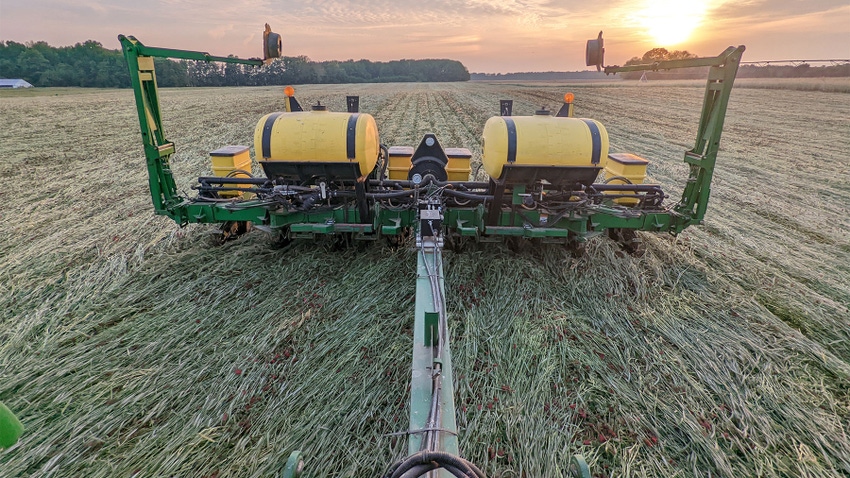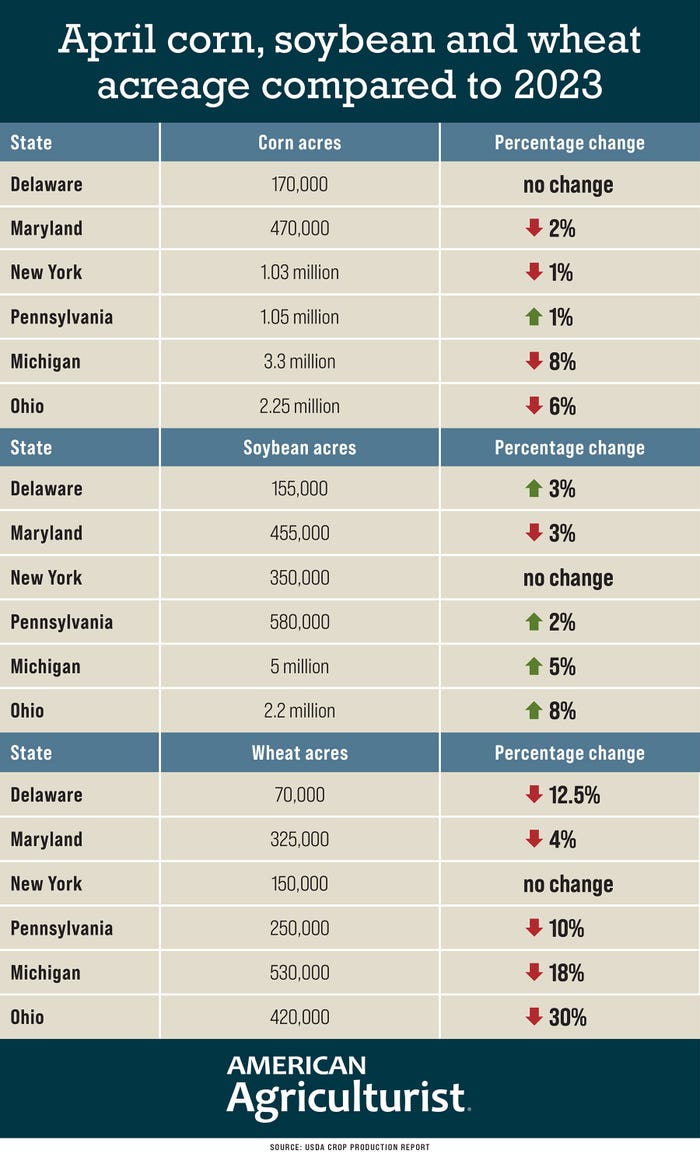
Following the national trend, growers in the region say they are planting more soybeans and less corn, and they plan to harvest much less winter wheat than previous years.
Take a look at data from the recent USDA Prospective Plantings report for the Northeast and mid-Atlantic:

Growers in each mid-Atlantic and Northeast state, except for Delaware and Pennsylvania, intend to plant less corn this season.
Not counting Michigan or Ohio, Pennsylvania has the most corn acres in the mid-Atlantic and Northeast at 1.05 million acres, followed by New York at 1.03 million acres.
And like the national trend, some of these corn acres are being rotated into or replaced by soybeans. Every state except Maryland will see more soybean acres this season.
Not counting Michigan or Ohio, Pennsylvania has the most soybean acres at 580,000 acres, followed by Maryland. New York, at 350,000 acres, will see its largest soybean planting on record, according to USDA.
Winter wheat-planted area is down significantly. Every state except Maryland and New York reported a double-digit percentage decline in planted area. Winter wheat acreage in Michigan is down 30% from last year. The state’s 420,000 acres are a record low, according to USDA.
National view
Nationally, corn-planted area is estimated at 90 million acres, down 5% or 4.61 million acres from last year. Compared with last year, planted acreage is expected to be down or unchanged in 38 of the 48 estimating states.
Soybean-planted area for 2024 is estimated at 86.5 million acres, up 3% from last year. Compared to last year, planted acreage is up or unchanged in 24 of the 29 estimating states.
Nationally, all wheat-planted area is estimated at 47.5 million acres, down 4% from 2023. The winter wheat-planted area, at 34.1 million acres, is down 7% from last year — and down 1% from the previous estimate for comparable states.
Jacqueline Holland, grain analyst for Farm Futures, said in a recent article that the numbers surprised her somewhat.
“The shift toward a 50-50 split for corn and soybean acreage is very apparent this year,” she said. “Crop budgets for soybeans are currently holding on to very slight profits, while corn budgets are far into the red, so growers that opted to wait until this spring to make acreage decisions likely found themselves favoring soybean acres over corn this year.
“I was most surprised to see a downturn in hay acres expected to be harvested this year,” she adds. “Not only did corn lose acres relative to last year, but small-grain acreage is also expected to contract compared to 2023. Sorghum, oats, barley and winter wheat acres were all reduced from last year, giving way to oilseeds and edible legumes.”
Here’s a complete list of prospective plantings for some of the other states across the region:
Corn
Connecticut, 24,000 acres, unchanged
Maine, 30,000 acres, up 7.1%
Massachusetts, 15,000 acres, up 7.1%
New Jersey, 72,000 acres, down 2.7%
Vermont, 90,000 acres, up 1.1%
Soybeans
Delaware, 155,000 acres, up 3.3%
New Jersey, 110,000 acres, up 10%
Hay
Connecticut, 53,000 acres, up 2%
Delaware, 11,000 acres, unchanged
Maine 140,000 acres, up 4%
Maryland, 220,000 acres, up 2%
Massachusetts, 60,000 acres, unchanged
Michigan, 800,000 acres, up 1%
New Jersey, 95,000 acres, down 13%
New York, 1.31 million acres, up 6%
Ohio, 820,000 acres, down 1%
Pennsylvania, 1.36 million acres, up 1%
Vermont, 175,000 acres, up 6%
Barley
Delaware, 21,000 acres, no change
Maine, 11,000 acres, no change
Maryland, 34,000 acres, up 21%
New York, 9,000 acres, unchanged
Pennsylvania, 37,000 acres, down 10%
Oats
Maine, 26,000 acres, unchanged
Michigan, 60,000 acres, up 20%
New York, 80,000 acres, up 18%
Ohio, 30,000 acres, down 40%
Pennsylvania, 78,000 acres, down 10%
About the Author(s)
You May Also Like






